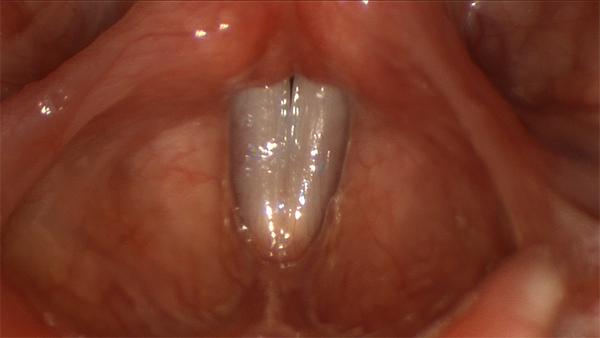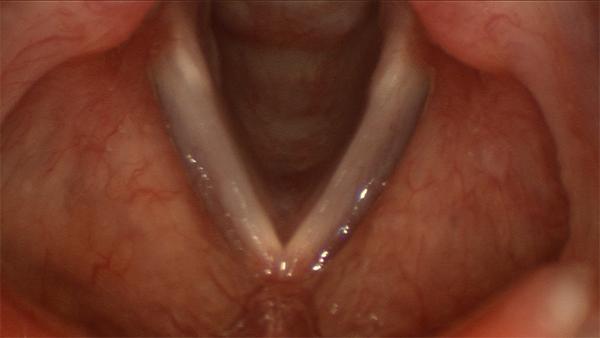Voice is produced by vibration of the vocal folds. The vocal folds are a pair of pliable shelves of tissue that stretch across the top of the trachea (windpipe). They are enclosed within the thyroid cartilage, which is the hard structure that forms the mass in the neck known as the Adam’s apple. The vocal folds, together with the muscles and cartilages that support them, are known as the larynx.
Vocal Cords and Vocal Folds
'Vocal fold’ is the modern term for ‘vocal cord.’ The change in terminology came about because of a better understanding of the anatomy and function of the larynx. ‘Vocal cord’ suggests a band or string suspended in the air that vibrates when it is plucked or struck. In fact, the vocal fold is a part of a muscle on the side of the larynx, covered with special tissues that can vibrate at a high speed. It resembles a lip of tissue much more than a cord. Only its outer covering vibrates.
Biologically, the larynx evolved as a valve to protect the airway and lungs. Thus, it is positioned where the airway and the esophagus separate. The vocal folds open to allow breathing and close during swallowing to prevent food from entering into the lungs and during voicing.

Vocal folds in the closed position during voicing

Vocal folds in the open position for breathing
Each section below details a separate aspect of voice.
Sound
In order to produce voice, the lungs blow air against vocal folds in the nearly-closed position. Air pushes through the very small space between them and in so doing, makes the covering of the vocal folds, known as the mucosa, vibrate. This occurs by means of a phenomenon known as the venturi effect. As air passes through a constriction (or venturi), it speeds up and creates a suction in its wake. This suction draws in the pliable mucosa from each vocal fold, which meet in the midline only to be pushed aside by more air from the lungs. This cycle creates a repeating undulation which is known as the mucosal wave. The regularity of the mucosal wave is essential to the production of good voice.
The mucosal wave during voicing:
Stroboscopy
The videos on this site show vocal fold vibration in slow motion by means of a technique known as stroboscopy. In reality, vocal folds vibrate in excess of 100 times per second during voicing, and sometimes many times faster. A laryngeal stroboscope uses a microphone to detect the frequency of vibration of the vocal folds during phonation, and times the flashing of a stroboscopic light bulb just slightly out of phase with it. The resulting video creates the impression of watching the vocal folds vibrate in slow motion.
The pliability of the mucosa depends on the integrity of the layer immediately beneath it, known as the superficial lamina propria, or Reinke’s layer, named after the man who described it. It is a special network of substances, unique in the body, that can support the stresses of vocal fold vibration over the long term.
Loudness
The volume of sound is principally a result of the pressure of the air that is blown past the vocal folds. A more forceful expulsion of air from the lungs raises this pressure. Of course, the vocal folds must increase tension to maintain the near-closure that is needed for the venturi effect. If they do not, the increased air pressure will simply blow them aside and interrupt vibration. This tensing of the vocal folds usually happens instinctively, without conscious effort. People with vocal fold paralysis or other types of vocal fold weakness are often unable to do this, and frequently complain of an inability to increase the volume of their voice.
Pitch
The frequency of the mucosal wave determines the pitch of the voice. In addition to opening and closing, the vocal folds are able to lengthen and shorten, and this forms an important means of increasing vocal fold tension. Just as tuning a guitar string will adjust its pitch, so will changing tension on the vocal folds. In the case of vocal folds, however, tension must be altered symmetrically. A person performs this activity rapidly and precisely, and many times over the course of a short conversation.
The vocal folds lengthen in order to raise the pitch of the voice.
Hoarseness
Hoarseness is the result of irregularity of mucosal vibration. Very many factors influence the formation and maintenance of the mucosal wave, but broadly speaking, these can be simplified to two: vocal fold closure and the integrity of the superficial lamina propria. Inability of the vocal folds to close sufficiently, as in some cases of vocal fold paralysis, may make it impossible to create the venturi effect which underlies mucosal vibration. Tethered or stiff mucosa resulting from a change in the lamina propria, as in vocal fold scar, will not vibrate well or at all, regardless of the vocal fold closure. Sometimes, a large mass like a cyst or polyp blocks both the vocal folds from closing and the mucosa from vibrating.

